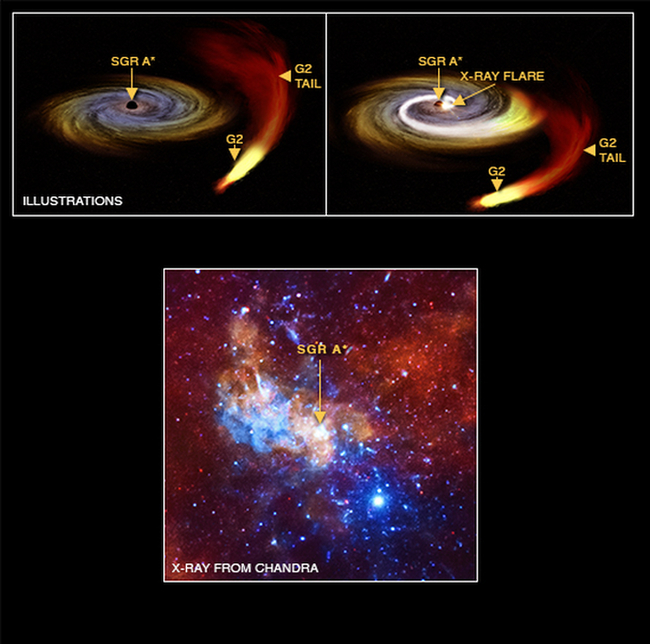
 Credit: NASA/CXC/MPE/G.Ponti et al; Illustration: NASA/CXC/M.Weiss
Credit: NASA/CXC/MPE/G.Ponti et al; Illustration: NASA/CXC/M.Weiss
Acting Up?
The center of the Milky Way is an active place. A few years ago, astronomers identified an interloper, an object called "G2", which seemed to be on a near collision-course with the Milky Way's central supermassive black hole, the object known as Sagittarius A* (or Sgr A* for short). The nature of G2 is not clear; it may simply be a cloud of dust, or it may be an entire solar system surrounded by a dust cloud. The possibility that part (or all) of G2 could fall into the black hole, disappearing from our Universe, was an exciting prospect and so astronomers monitored Sgr A* with an entire complement of ground-based and space-based telescopes covering almost the entire electromagnetic spectrum. X-ray observations by the Chandra X-ray Observatory and the XMM-Newton X-ray Observatory were a key part of this observing campaign. The lower part of the image above shows a Chandra X-ray image of the center of the Milky Way, with the position of Sgr A* marked. The colors in the image represent X-ray energy: red for low-energy X-rays, green for medium-energy X-rays, and blue for high-energy X-rays. In 2013, G2 apparently passed very close to Sgr A*, and, unfortunately, there we no obvious strong change from Sgr A*. Perhaps this was good news for G2, indicating the object escaped the gravitational clutches of Sgr A*. But perhaps G2 was not so lucky. A recent analysis of detailed observations with Chandra and XMM-Newton of Sgr A* from 1999 to 2014 showed that, starting in late summer 2014, there was a ten-fold increase in the rate of bright X-ray flares from Sgr A*. The rate of X-ray flaring increased from about 2 flares every 10 days to 2 flares per day. This could mean that some material from G2 spiralled onto Sgr A*, heating up and producing a series of X-ray flashes as it was swallowed by the supermassive black hole, similar to the illustrations shown in the upper part of the image above. These illustrations imagine G2 passing by Sgr A*, and some material from its tail being captured by the black hole, and lighting up the accretion disk surrounding the black hole. On the other hand, perhaps this type of change is simply a characteristic, previously unrecognized behavior of the emission from Sgr A*. But as Yogi Berra purportedly said, perhaps "that's too coincidental to be a coincidence".
Published: October 12, 2015
<
HEA Dictionary ● Archive
● Search HEAPOW
● Other Languages
● HEAPOW on Facebook
● Download all Images
● Education ● HEAD
>

Each week the HEASARC
brings you new, exciting and beautiful images from X-ray and Gamma ray
astronomy. Check back each week and be sure to check out the HEAPOW archive!
Page Author: Dr. Michael F. Corcoran
Last modified Monday, 26-Feb-2024 17:23:49 EST


